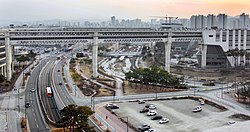
Back Sejong Afrikaans سيجونغ سيتي Arabic Kota Séjong BAN Sejong Bislama সেজং শহর Bengali/Bangla Sié-cŭng Dĕk-biék Cê̤ṳ-dê-chê CDO Sejong-si CEB Sedžong (město) Czech Sejong (Stadt) German Σέτζονγκ Greek
This article needs to be updated. (November 2018) |
It has been suggested that Yeongi County be merged into this article. (Discuss) Proposed since March 2024. |
Sejong
세종특별자치시 | |
|---|---|
| Sejong Special Self-Governing City | |
| transcription(s) | |
| • Korean | 세종특별자치시 |
| • Hanja | 世宗特別自治市 |
| • Revised Romanization | Sejong Teukbyeol-jachisi |
| • McCune-Reischauer | Sejong T'ŭkpyŏl-chach'isi |
 | |
 | |
 | |
| Coordinates: 36°29′13″N 127°16′56″E / 36.487002°N 127.282234°E | |
| Country | Republic of Korea |
| Region | Hoseo |
| First settled | 2012 |
| Neighbourhood Town Townships | 12 1 9 |
| Government | |
| • Type | Mayor–Council |
| • Mayor | Choi Min-ho (People Power) |
| • Body | Sejong City Council |
| Area | |
| • Total | 465.23 km2 (179.63 sq mi) |
| Population (October 2020) | |
| • Total | 351,007[1] |
| • Dialect | Chungcheong |
| GDP | |
| • Total | KR₩ 14 trillion US$ 11 billion (2022) |
| Time zone | UTC+9 (Korea Standard Time) |
| Area code | +82-44 |
| Flower | Peach |
| Tree | Pine |
| Bird | Oriental magpie |
| Website | Official website (English) |

Sejong or Sejong City (Korean: [seːdʑoŋ] ⓘ; Korean: 세종; Hanja: 世宗), officially the Sejong Special Self-Governing City[3] (세종특별자치시; 世宗特別自治市), is a special self-governing city and the de facto administrative capital of South Korea.
Sejong was founded in 2007 as the new planned capital of South Korea from many parts of the South Chungcheong province and some parts of North Chungcheong province to ease congestion in South Korea's current capital and largest city, Seoul, and encourage investment in the country's central region. Since 2012, the government of South Korea has relocated numerous ministries and agencies to Sejong, but many still reside in other cities, primarily Seoul, where the National Assembly and many important government bodies remain.
Sejong has a population of 351,007 as of 2020 and covers a geographic area of 465.23 km2 (179.63 sq mi), making it the least-populous and smallest first-level administrative division in South Korea. Sejong is located in the west-central Hoseo region, bordering South Chungcheong to the west, Daejeon Metropolitan City to the south, and North Chungcheong to the east.
The construction of the city is expected to be completed in 2030, at which time 500,000 people are expected to live there.[4]
- ^ 세종특별자치시청. "Document Viewer" 한눈에보는 세종 >. www.sejong.go.kr.
- ^ "2022년 지역소득(잠정)". www.kostat.go.kr.
- ^ "Organization > Sejong City Hall > Happy City Sejong >". www.sejong.go.kr. Retrieved 2020-05-06.
- ^ "Mini-capital Sejong City opens". The Korea Times. 2012-07-01. Retrieved 2019-05-27.
© MMXXIII Rich X Search. We shall prevail. All rights reserved. Rich X Search




